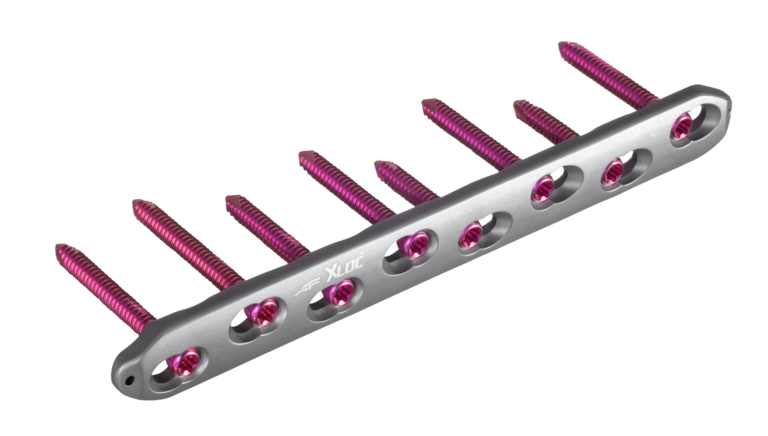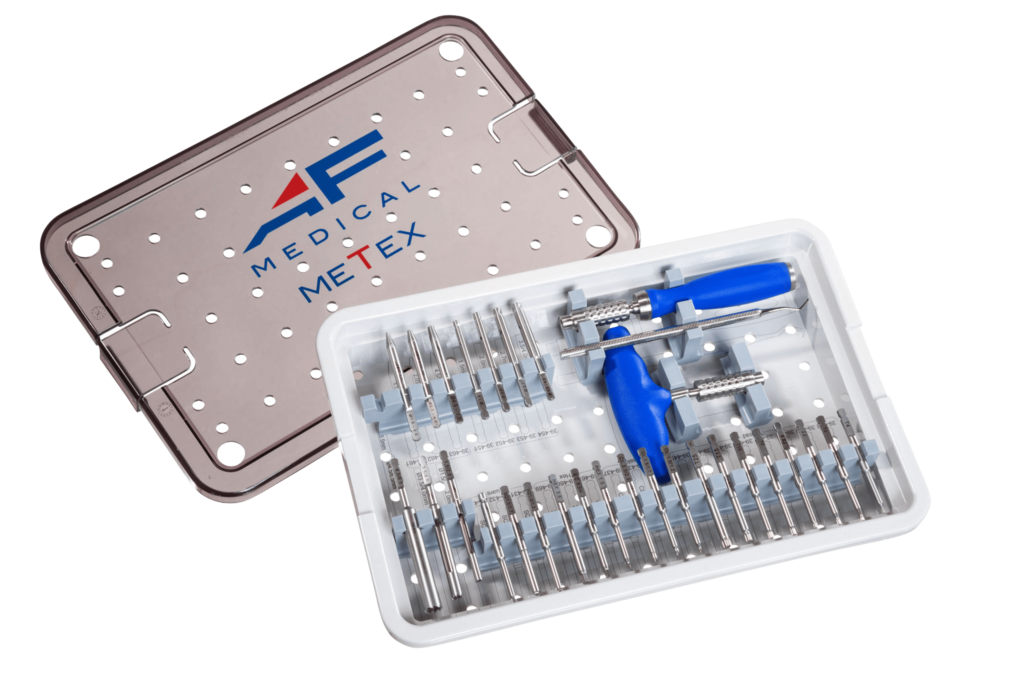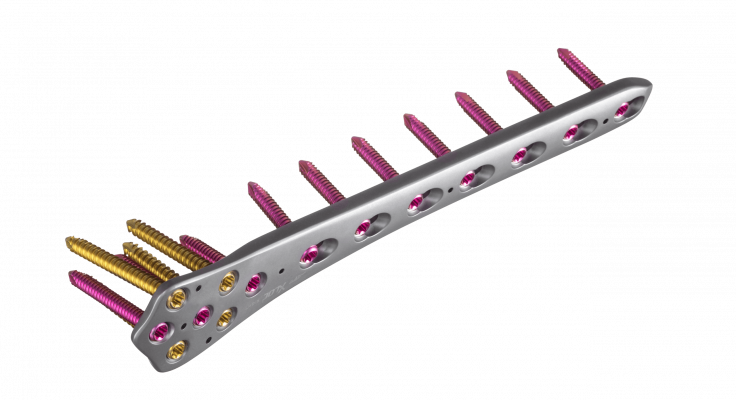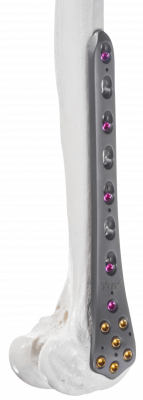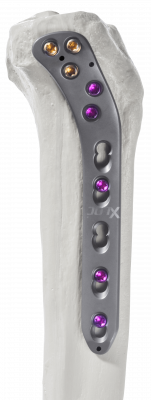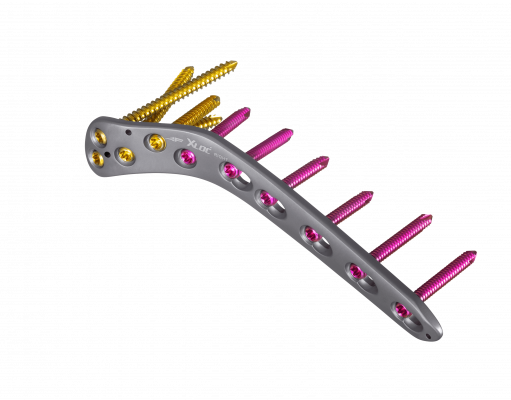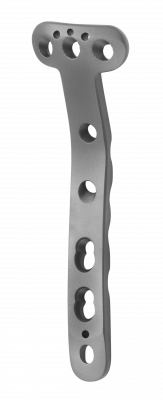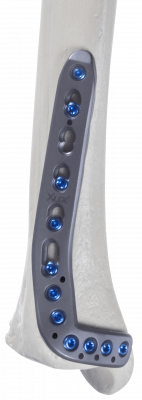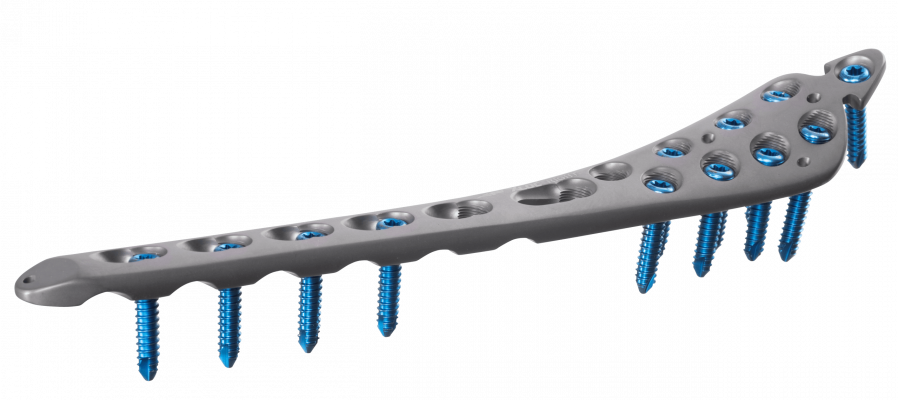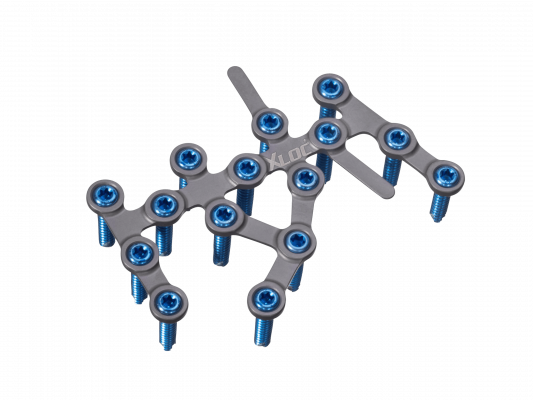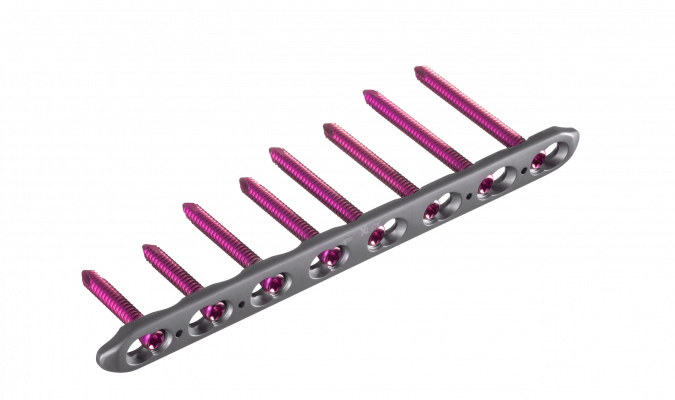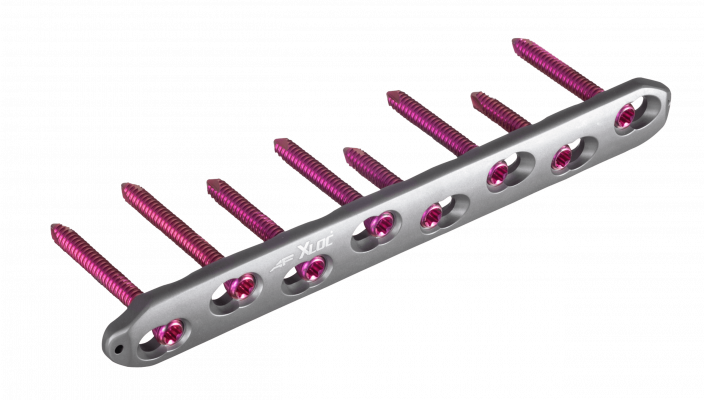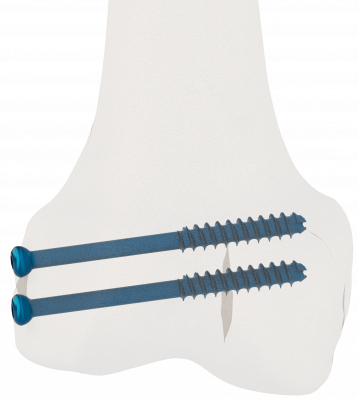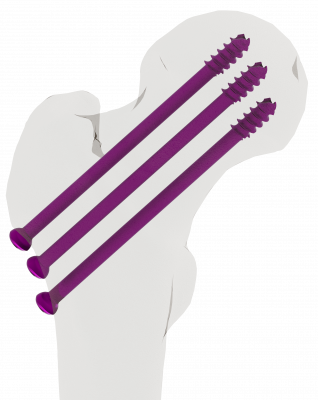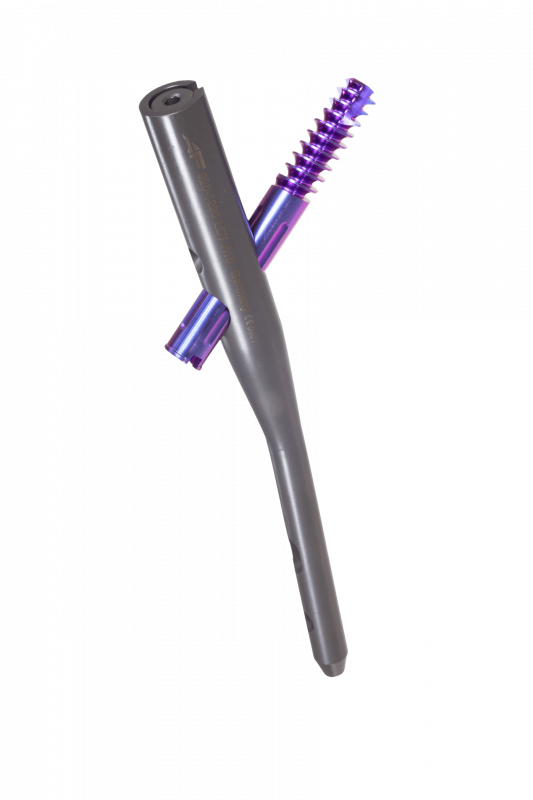Femur XLOC plate, proximal
The femur XLOC plate proximal is an anatomically pre-formed plate and intended for fractures of the proximal femur and the trochanter part. The plate combines four types of screws and is designed for the left and right femur in order to cover different femur neck anteversion.
- High grade Titanium material
- Anodized type II
- Reduced risk of cold welding
- Good biocompatibility
- Available in left and right plates
- Distal head contoured design for optimal positioning
- 2 to 16 holes
- K-wire holes supports plate positioning
- Limited contact profile to protect the blood supply
- Conical plate tip
- Rounded edges and shaft profile reduce the soft tissue irritation
- Shaft with compression holes for dynamic axial compression for common Ø 4.5 mm cortical screws
- Proximal locking holes for XLOC 7.3 screws cannulated
- Shaft locking holes for XLOC Ø 5.0 mm locking screws
Femur XLOC plate, distal
The proximal head of the femur XLOC plate is anatomically precontoured and the curved shaft is designed to follow the natural shape of the femur bone.
- Shaft fractures
- Supracondylar fractures
- Intra-articular fractures
- Periprosthetic fractures
Tibia XLOC plate, proximal lateral
The proximal tibia plate for bone fixation of the proximal lateral tibia. The tibia XLOC plate has an anatomically pre-shaped proximal head. The shaft of that anatomical bone implant is adapted to the Tibia bone.
- High grade Titanium material
- Anodized type II
- Reduced risk of cold welding
- Optimal biocompatibility
- Available as left and right anatomic shaped plates
- Proximal head shaped design for optimal positioning
- Sizes from 5 to 13 holes
- K-wire holes support plate positioning
- Conical tapered plate tip
- Rounded edges and shaft profile reduce irritation of soft tissue
- Shaft with compression holes for dynamic axial compression for common Ø 4.5 mm cortical bone screws
- Proximal and distal locking holes for XLOC Ø 5.0 mm locking screw
Tibia XLOC plate, proximal medial
Proximal medial tibia plate for bone fixation of the proximal medial tibia with XLOC 3.5 or 4.0 screws. The head of the tibia XLOC plate is anatomically pre-shaped to fit the medial head of the proximal tibia.
- High grade Titanium material
- Anodized type II
- Hardened Titanium surface
- Reduced risk of cold welding
- Optimal biocompatibility
- Available as left and right anatomic shaped plates
- Proximal head shaped design for optimal positioning
- sizes from 4 to 14 holes
- K-wire holes support plate positioning
- Conical tapered plate tip
- Rounded edges and shaft profile reduce irritation of soft tissue
- Shaft with compression holes for dynamic axial compression for common Ø 3.5 mm cortical bone screws
- Proximal and distal locking holes for XLOC Ø 3.5 or 4.0 mm locking screw
- Limited contact profile to protect the blood supply
Tibia XLOC L-plate, proximal lateral
Proximal tibia plate for bone fixation of the proximal lateral tibia with XLOC 3.5 or 4.0 screws. The head of the tibia XLOC plate is anatomically pre-shaped to fit the lateral head of the proximal tibia.
- High grade Titanium material
- Anodized type II
- Reduced risk of cold welding
- Optimal biocompatibility
- Available as left and right anatomic shaped plates
- Proximal head shaped design for optimal positioning
- Sizes from 4 to 14 holes
- K-wire holes support plate positioning
- Conical tapered plate tip
- Rounded edges and shaft profile reduce irritation of soft tissue
- Shaft with compression holes for dynamic axial compression for common Ø 3.5 mm cortical bone screws
- Proximal and distal locking holes for XLOC Ø 3.5 or 4.0 mm locking screw
Tibia XLOC Plate, distal anterolateral
The tibia XLOC distal anterolateral plates are intended for fractures of
- Extra-articular
- Simple intra-articular
- Fractures extending into the diaphyseal area of the distal tibia.
The tibia XLOC distal medial plate has an anatomically pre-shaped distal head. The shaft of the plate is bent and twisted in order to fit the bone of the distal tibia.
- High grade Titanium material
- Anodized type II
- Reduced risk of cold welding
- Good biocompatibility
- Available in left and right plates
- Distal head shaped design for optimal positioning
- Proximal shaft bent and twisted for fitting the bone
- 5 to 15 holes
- K-wire holes supports plate positioning
- Conical plate tip
- Limited contact profile to protect the blood supply
- Rounded edges and shaft profile reduce the soft tissue irritation
- Shaft with compression holes for dynamic axial compression for common Ø 3.5 mm cortical screws
- Proximal and distal locking holes for XLOC Ø 3.5 mm locking screws
- Distal locking holes for XLOC Ø 4.0 mm cancellous locking screws
Tibia XLOC Plate, Distal Medial
The tibia XLOC distal medial plates are intended for fractures of the distal tibia. The tibia XLOC plate has an anatomically pre-shaped distal head. The shaft of the plate is bent and twisted in order to fit the bone of the distal tibia.
- High grade Titanium material
- Anodized type II
- Reduced risk of cold welding
- Good biocompatibility
- Available in left and right plates
- Distal head shaped design for optimal positioning
- Proximal shaft bent and twisted for fitting the bone
- 4 to 14 holes
- K-wire holes supports plate positioning
- Conical plate tip
- Limited contact profile to protect the blood supply
- Rounded edges and shaft profile reduce the soft tissue irritation
- Compression holes for dynamic axial compression for common Ø 3.5 mm cortical screws
- Proximal and distal locking holes for XLOC Ø 3.5 mm locking screws
- Distal locking holes for XLOC Ø 4.0 mm cancellous locking screws
- Distal tab for medial malleolus
Tibia XLOC plate, distal medial, without Tab
The tibia XLOC distal medial plates are intended for fractures of the distal tibia. The tibia XLOC plate has an anatomically pre-shaped distal head. The shaft of the plate is bent and twisted in order to fit the bone of the distal tibia.
- High grade Titanium material
- Anodized type II
- Reduced risk of cold welding
- Good biocompatibility
- Available in left and right plates
- Distal head shaped design for optimal positioning
- Proximal shaft bent and twisted for fitting the bone
- 4 to 14 holes
- K-wire holes supports plate positioning
- Conical plate tip
- Limited contact profile to protect the blood supply
- Rounded edges and shaft profile reduce the soft tissue irritation
- Compression holes for dynamic axial compression for common Ø 3.5 mm cortical screws
- Proximal and distal locking holes for XLOC Ø 3.5 mm locking screws
- Distal locking holes for XLOC Ø 4.0 mm cancellous locking screws
- Distal tab for medial malleolus
Calcaneal XLOC Plate
The calcaneal XLOC plate is indicated for:
- Fractures of the calcaneus
- Osteotomies of the calcaneus
- Extra-articular, intra-articular, joint depression
- Tongue type fractures
- High grade Titanium material
- Anodized type II
- Reduced risk of cold welding
- Good biocompatibility
- Available in left and right plates
- 15 XLOC locking holes for XLOC Ø 3.5 mm locking screws
- Usable also with standard cortical screws Ø 3.5 mm usable
- Application laterally
- Adaptable tabs
Narrow XLOC plate, low contact
Inidcated for fractures of various long bone fragments of humerus, femur and tibia.
- High grade Titanium material
- Anodized type II
- Reduced risk of cold welding
- Good biocompatibility
- 6 to 18 holes
- K-wire holes supports plate positioning
- Rounded edges and shaft profile reduce the soft tissue irritation
- Compression holes for dynamic axial compression for common Ø 4.5 mm cortical screws
- Locking holes for XLOC Ø 5.0 and XLOC Ø 5.0 mm cancellous locking screws
- Conical plate tip
- Limited contact profile to protect the blood supply
Broad XLOC plate, low contact
Inidcated for fractures of various long bone fragments of humerus, femur and tibia.
- High grade Titanium material
- Anodized type II
- Reduced risk of cold welding
- Good biocompatibility
- 6 to 18 holes
- K-wire holes supports plate positioning
- Rounded edges and shaft profile reduce the soft tissue irritation
- Compression holes for dynamic axial compression for common Ø 4.5 mm cortical screws
- Locking holes for XLOC Ø 5.0 and XLOC Ø 5.0 mm cancellous locking screws
- Conical plate tip
- Limited contact profile to protect the blood supply
RECONSTRUCTION 3.5 XLOC PLATE
The reconstrution 3.5 XLOC is indicated for fractures of:
- Small bone fragments
- Clavicula
- Humerus
- Pelvic
- Calcaneal
- High grade Titanium material
- Anodized type II
- Reduced risk of cold welding
- Good biocompatibility
- 4 to 12 holes
- K-wire holes supports plate positioning
- Rounded edges and shaft profile reduce the soft tissue irritation
- Compression holes for dynamic axial compression for common Ø 3.5 mm cortical screws and Ø 4.0 cancellous screws
- Locking holes for XLOC Ø 3.5 and Ø 4.0 mm cancellous locking screws
Cannulated screws
Our cannulated screw systems 3.5 / 4.0 / 4.5 and 7.0 conists of screws, washers, and instruments designed for surgical treatments of osteotomies, fusions or fractures of
- Small fragments e.g. fractures of wrist, tarsal, metatarsal or corrections of hallux valgus
- Medium fragments e.g. malleolar, calcaneus or tibial plateau
- Large fragments e.g. intercondylar femur or femoral neck
- Low profile heads to reduce potential for sof-tissue irritation
- Excellent self-drilling and self-tapping tips
- Reverse cutting thread for easier screw removal
- Standard hexagonal screw heads is compatible with screwdrivers in other commonly used AF instrument sets.
AFTron – AF Trochanter Nail System
The AFTron Trochanter Nail is designed for indications
involving the treatment of unstable subtrochanteric, pertrochanteric and intertrochanteric fractures.
For shaft fractures in combination with trochanteric fractures the long version of AFTron nails is available. The nail is combining many of the features of a dynamic hip screw system and an intramedullary nail. Three different neck-shaft angles are available for lag screw insertion to accommodate
various femoral neck anatomy. AFTron nail provides the
surgeon the choice of using the lag screw in combination
with the compression screw or to insert the lag screw in
conjunction with the anti-rotation screw.
The load of the femoral head is transferred from the lag screw into the nail shaft in order to allow fast fracture healing. The lag screws are grooved to allow the set screw to fit into the same and to allow sliding of the lag screw to the lateral side of the fracture for dynamic bone compression. The set screw also avoids rotation and medial migration of the lag screw. In appropriate cases a 5.5 anti-rotation screw can be used in combination with the lag screw.
Distal locking screws with 5.0 diameter with a self-tapping tip facilitates easier and faster insertion. The distal locking screw is provided to stabilize the nail in the medullary canal and to reduce rotations of fractures.
They can be inserted in oblong holes either for static or dynamic locking.
- 3 proximal nail angles: 125°, 130°, 135°
- Proximal diameter Ø 16 mm
- Nails with bending for valgus curvature
- Nail diameters 10 to 12 mm
- Distal oblong hole for dynamic locking
- Screw plugs up to 10 mm
- 10.5 mm lag screws, self-tapping tip
- 5.5 anti-rotation screw, self-tapping
- Cannulated lag screw
- 5.0 mm distal locking screws, self-tapping, fully threaded


